This Bamya Recipe is a simple yet flavorful dish from Middle Eastern cuisine. With just a few key ingredients – fresh young okra, ripe tomatoes, onion, garlic, and a squeeze of lemon – you can easily whip up this tasty okra stew.

The name "Bamya" originates from the Arabic word for okra. It is very popular in Egypt, Iraq, Iran, Lebanon, and Syria. But it's not just the Middle East. You'll find bamya in Turkey and Greece too, where they add their own special touches to the recipe.
Despite the changes, the main ingredients are usually the same - okra, tomatoes, onions, garlic, and a bit of lemon.
We love cooking okra stew during the vibrant summer months! The fresh okra is at its peak, and the tomatoes are wonderfully ripe. There's something incredibly comforting about simmering these ingredients together. And we always freeze okra during summer to enjoy it in various dishes later.
This rich and hearty okra stew is great when paired with a side of fluffy rice like Turkish rice or vermicelli rice The combination is simply divine. Whether it's for a weekday dinner or a weekend gathering, our bamya and rice combo is a summer tradition we look forward to.
The Origin
Where is bamieh from?
Middle Eastern Okra Stew, also known as bamya, bamia or bamiyeh, is a delicious dish that's found in many cuisines, each with their own spin on it.
The dish is believed to have originated in Egypt. Here, it's common to find both vegetarian and meat versions, with the meat being either beef or lamb.
Iraq, Iran, Lebanon, and Syria also feature this delightful stew in their cuisines. In these countries, bamia recipe can be prepared with meat, typically beef or lamb, or as a vegetarian dish. Chicken is sometimes used too, but it's not as popular as beef or lamb. And the spices in the dish might be different in each cuisine.
In Turkey, there are several versions of it. The most popular three versions are: 1) Olive oil bamya. It is served cold, sometimes as a part of meze platter and with a generous amount of olive oil. 2) Turkish Okra Stew. It is a comforting dish (with or without meat) with lots of tomatoes. 3) Okra soup, which is called "Bamya Çorbası". It uses dried baby tomatoes and small chunks of meat.
In Greece has a similar dish called "Bamies", which is usually vegetarian, focusing on the fresh flavors of okra, olive oil, and Mediterranean spices.
Why You Will Love This Recipe
- Easy to Make: You need just a few fresh ingredients and simple steps.
- Full of Flavor: Despite its simplicity, bamya packs a punch when it comes to flavor.
- Healthy: Okra is high in fiber, vitamin C, and folate. This means that not only is bamya delicious, but it's also a nutritious choice!
- Customizable: This is a vegan version of the dish but you can make it with meat too if you like.
About The Ingredients
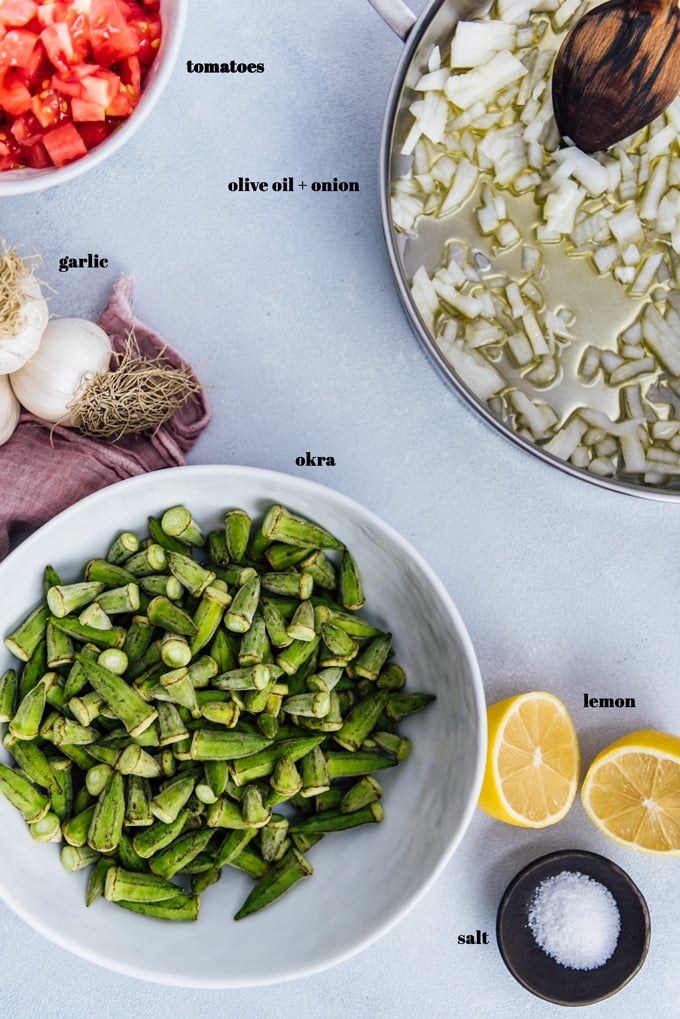
Okra:
Middle Eastern okra stew is always made with whole okra. Opt for fresh okra pods that are young, bright green and firm to touch.
Unlike African okra recipes, this Middle Eastern okra is never chopped, so large okra pods are not preferred in this dish. If you have large okra pods, use them to make okra chips or air fried okra.
Frozen baby okra can also be used as a substitute when fresh okra isn't available. Also, check out our air fryer frozen okra recipe!
If you have cut okra, then we suggest making either fried breaded okra or roasted okra.
Onion:
It forms the base of the stew, providing a sweet depth of flavor. Any type of onion can be used, but yellow or white onions are most common. If you prefer a milder onion flavor, sweet onions can be a good substitute.
Olive Oil:
It is used to sauté the onions and garlic, helping to release their flavors and adding a smooth richness to the stew. If you don't have olive oil, other neutral oils like canola or sunflower oil can be used, but olive oil is preferred for its distinct flavor.
Tomatoes:
They add a tangy sweetness to the stew and create a rich, hearty base. Fresh, ripe tomatoes are best, but canned tomatoes can also be used if fresh ones are not available.
Garlic:
It adds a punch of flavor to the stew. Fresh cloves are ideal, but if they're not on hand, garlic powder can be used as a substitute.
Lemon:
It serves a dual purpose in this recipe. Firstly, soaking okra in lemon water can help reduce its slimy texture. Secondly, a squeeze of lemon juice while cooking not only enhances the flavors but also helps further minimize the okra's slime.
Alternative Add-Ins
- Tomato Paste: Adding tomato paste can deepen the flavor and color of your bamya. It gives the stew a more robust tomato profile and adds richness.
- Black Pepper: A dash of black pepper can add a subtle heat to the dish, enhancing the overall flavor profile.
- Coriander, Cumin, Turmeric, and Paprika: These spices can add complexity and warmth to the stew. Coriander offers a lemony, earthy flavor, while cumin provides a bit of smokiness. Turmeric adds a beautiful golden color and a mild, earthy flavor. Paprika, whether sweet or smoked, gives the dish a touch of sweetness or smokiness, respectively.
- Vegetable, Chicken, or Beef Stock: Using stock instead of water can amplify the flavors of your Bamya. Choose a stock that complements your choice of ingredients - vegetable stock for a vegetarian stew, and chicken or beef stock if you're using meat.
- Pomegranate Molasses: It is used when making Lebanese okra stew or Iraqi bamia recipe. So for even a richer taste, you can try it (about 1 tablespoon) as a substitute for lemon juice in the dish.
- Verjuice: In traditional Turkish okra stew recipes, sometimes fresh verjuice is used as a substitute for lemon juice. It adds a unique tangy flavor to the stew.
- Parsley (for garnish): A sprinkling of fresh parsley on top of the stew before serving adds a burst of freshness and a pop of color, enhancing the dish visually and flavor-wise.
How To Make It
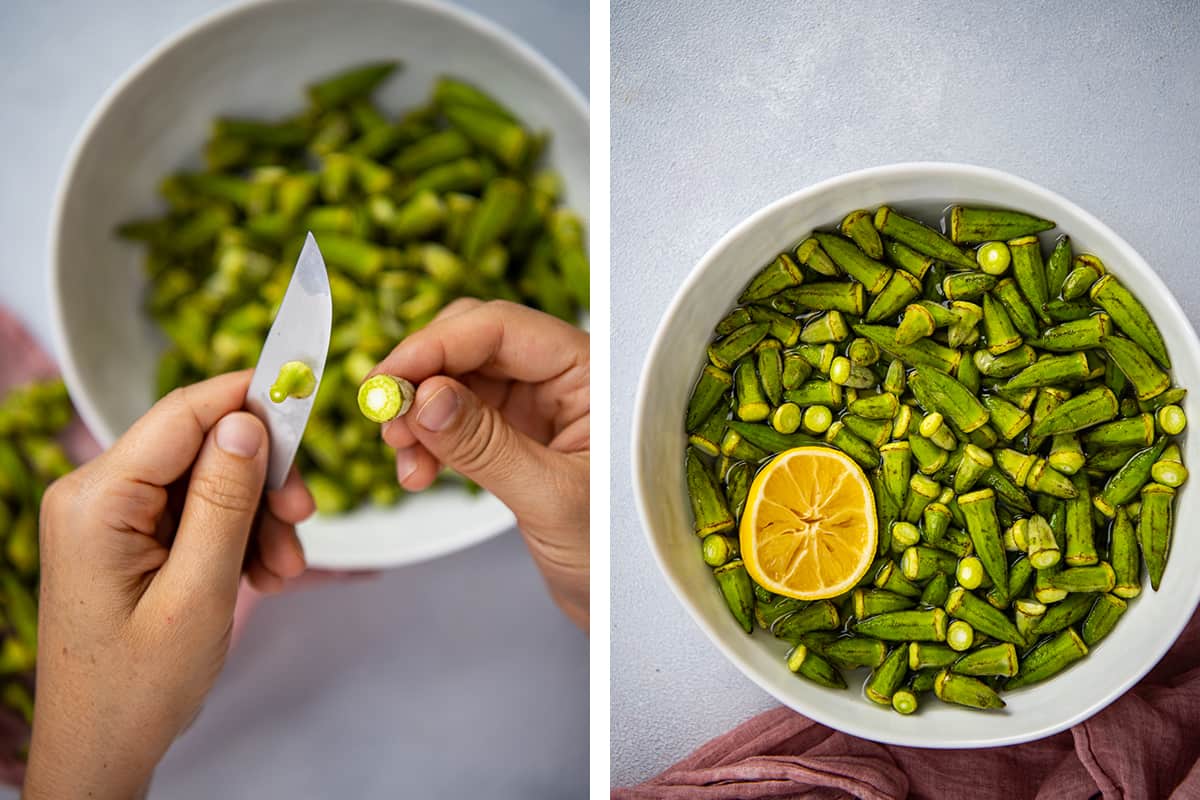
Prepare the Okra: Start by cleaning and washing your okra pods. Try not to cut the stems too deep. Otherwise, it will get slimy. Then, squeeze the juice of a half lemon onto the okra, pour water on it. Allow this to sit for about 10 minutes. Be gentle when handling the okra during these steps to avoid breaking the pods. This lemon treatment will help reduce the sliminess of the okra.
Pro Tip: You can substitute vinegar or lime juice for lemon. It has a similar acidity to help reduce the slime.

Sauté the Onion: While the okra is sitting with the lemon, heat some olive oil in a large pan or pot. Add the onions and sauté them until they turn a golden color.
Add Tomatoes and Garlic: Once the onions are golden, add your tomatoes and slices of garlic to the pan. Stir everything together and let it cook for about 5 minutes. This will allow the flavors to meld together and the tomatoes to break down a bit.
Add the Okra: Now, it's time to add your okra to the dish. Drain but don't rinse it. We want the okra pods to keep the lemon juice. Put them over the tomato base. Then, quickly squeeze half a lemon just onto the okra in the pot. Don't stir the mixture - just cover it and let it cook for about 5 minutes.
Pro Tip: For the best result, don't stir the okra too much. The okra will cook perfectly in the flavorsome base, even without much stirring. Over-stirring can increase the okra's "slime," so less is more in this case.
Add Water and Salt: After the okra has cooked for 5 minutes, pour in 2 cups of hot water and add salt to taste. Let it cook, covered with a lid, for about 20 minutes, or until the okra becomes tender.
Serve: It is now ready to serve. It's best served warm, with a side of rice and lemon wedges for an extra squeeze of freshness.
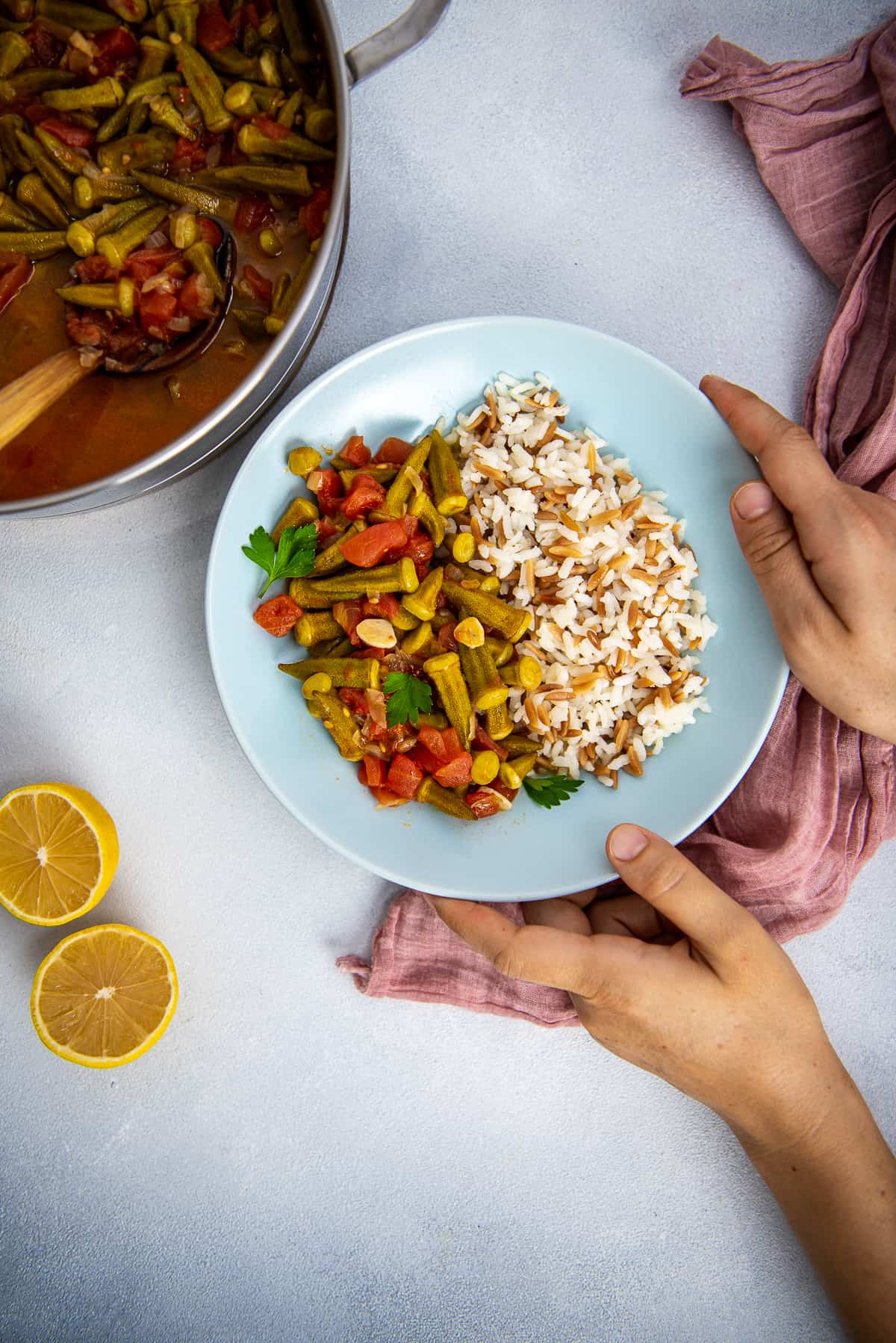
Variations
- Adding Meat: While this is a vegetarian bamya recipe, you can certainly add meat if you prefer. Both beef and lamb are commonly used in different versions of this dish across the Middle East and can add a hearty, rich flavor to the stew. You can even use ground beef or oxtail as in Egyptian okra stew recipes. Regardless of your meat choice, ensure it is cooked alongside the onions until it reaches a tender consistency, or alternatively, you can use pre-cooked meat.
- Spicy Version: If you enjoy a bit of heat, consider adding some chili flakes or a fresh, chopped chili pepper into the mix. This will give the stew a nice kick and a different flavor profile.
- Using Different Spices: Feel free to play around with the spices you use. Cumin, coriander, paprika, and turmeric can all bring unique flavors to the dish. Try different combinations and see what you like best!
- Adding Legumes: Some people like to add boiled chickpeas or fava beans to their Bamya for extra protein and texture. This can be a great way to make the stew even more filling.
Our Tips
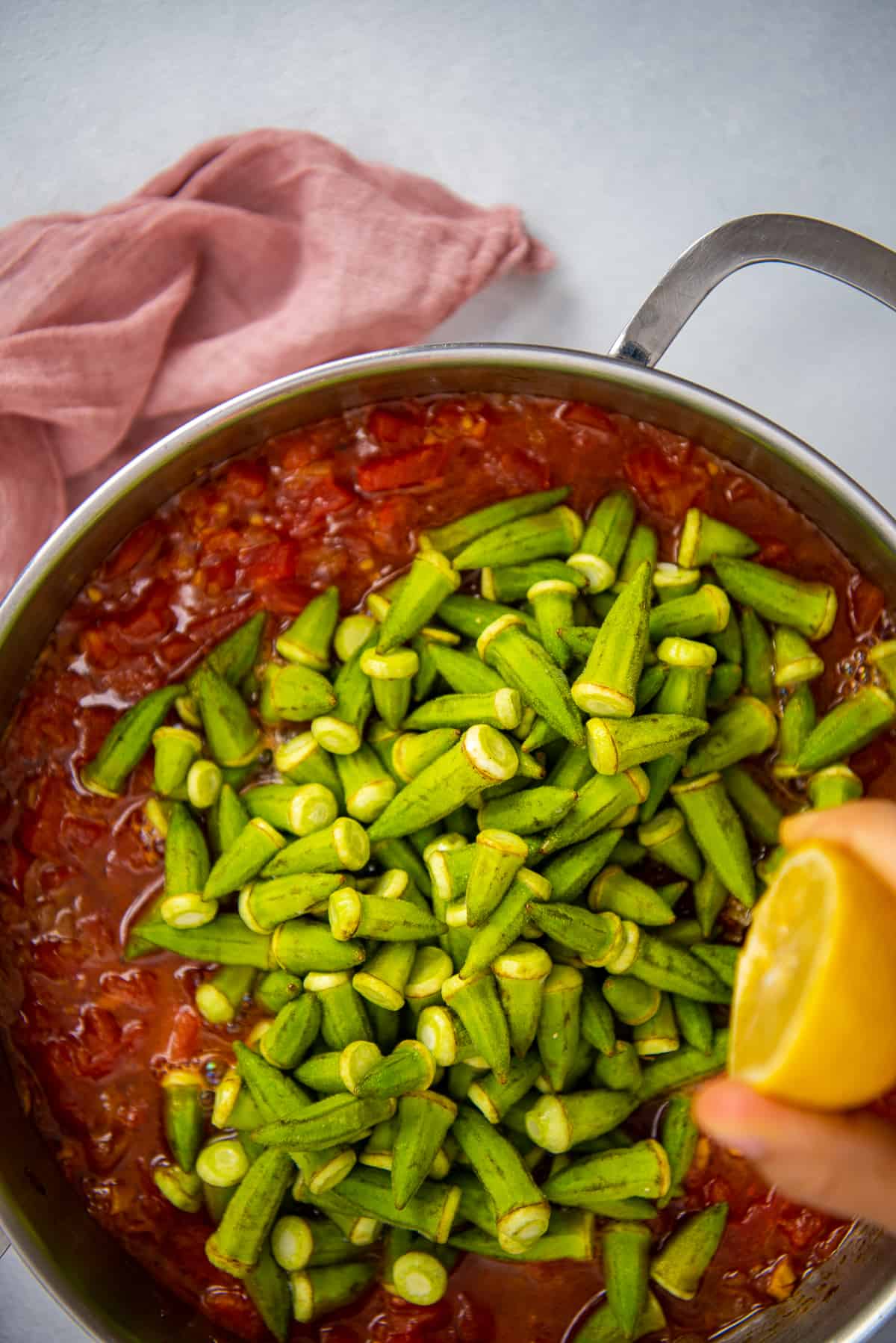
- Choosing Okra: For the best flavor and texture, choose young, fresh okra pods. The smaller, the better. They should be bright green and firm to the touch.
- Handling Okra: To reduce the sliminess, soak the okra in lemon water before cooking and don't stir it too much once it's in the stew.
- Using Fresh Tomatoes: If possible, use fresh, ripe summer tomatoes for the best flavor. If you can't find fresh tomatoes, canned tomatoes can be a good substitute.
- Cooking Slowly: Take your time when cooking bamya. Cook it over medium-low heat to allow the flavors to blend together and the okra to become tender.
Serving Suggestions
- Serve with Rice: Bamya is traditionally served over a bed of rice. The rice soaks up the delicious stew juices and makes for a heartier meal. We love to pair it with rice pilav, ic pilav (rice with raisins) or bulgur pilav.
- Pair with Bread: Another great way to enjoy Bamya is with a side of warm, crusty bread. This is especially useful for mopping up the tasty tomato base. Our favorite breads to serve with it are Ramazan pidesi, pita bread, bazlama, no flour cornbread or lavash bread.
- Lemon Wedges: Always serve Bamya with a few lemon wedges on the side. A squeeze of fresh lemon juice just before eating can really brighten the flavors.
- Fresh Salad: A fresh, crisp salad makes an excellent side dish for bamyeh. The cool, refreshing vegetables can balance the warm, hearty stew perfectly. Our favorite is Turkish coban salad.
- Yogurt: Some people enjoy it with a side of fresh yogurt. The creamy, tangy yogurt can complement the rich flavors of the stew.
- Pickles: Pickled vegetables can add a tangy crunch that pairs well with the soft, hearty stew. Our favorites are pickled cabbage and refrigerator beet pickles.
Storing & Reheating
Storing: Once the stew has cooled to room temperature, it can be stored in an airtight container in the refrigerator for up to 3-4 days. If you need to store it for a longer period, it can also be frozen. Simply portion the stew into freezer-safe containers or heavy-duty freezer bags, and it should keep well for up to 2-3 months.
Reheating: To reheat refrigerated bamya, you can use the microwave or the stove. If using a microwave, heat the stew in a microwave-safe bowl, checking and stirring every minute or so until heated through. If you prefer to reheat it on the stove, transfer the stew to a saucepan and heat it over medium-low heat, stirring occasionally, until it's hot.
For frozen bamya, it's best to let it thaw overnight in the refrigerator before reheating. If you're in a hurry, you can reheat it straight from frozen, but you'll need to use a low heat and stir frequently to ensure the stew heats evenly.
FAQs
Soaking okra in lemon water before cooking and limiting the amount you stir it during cooking can help reduce its natural sliminess.
Yes, you can use frozen okra if fresh is not available. There's no need to thaw it. If possible, use frozen baby okra. Simply add it to your recipe as instructed, and it will cook and soften during the cooking process. It might take just a little longer.
Yes, it can be made in advance and stored in the refrigerator for 3-4 days or frozen for up to 2-3 months. Reheat it in the microwave or on the stove before serving.
Yes, it can be adapted to be made in a slow cooker or Instant Pot. Be sure to adjust cooking times accordingly, and remember not to stir the okra too much.
It has a unique, rich flavor profile. The okra offers a mild taste that is slightly sweet, almost grassy flavor, while the tomatoes, onions, and garlic add a savory depth. The lemon contributes a tangy brightness that balances out the dish. The okra can also have a unique texture, slightly firm on the outside but soft and almost creamy on the inside, particularly if cooked well in the stew.
Okra is packed with vitamins, minerals, and fiber. It's high in vitamins C and K, and provides good amounts of folate and magnesium. The high fiber content aids digestion and can help with weight management. Additionally, okra contains antioxidants that protect your body against harmful free radicals, potentially reducing the risk of chronic diseases.
More Okra Recipes
More Turkish Recipes
- Turkish Style Meatball Stew
- Kapuska (Turkish Cabbage Stew)
- Lahana Sarma (Turkish Cabbage rolls)
As always: If you make this recipe, let us know what you think by rating it and leaving a comment below. And post a pic on Instagram too—tag @give_recipe so we can see!
Sign up for the FREE GiveRecipe Newsletter to get the new recipes into your inbox! And stay in touch with us on Facebook, Pinterest, YouTube and Instagram for all the latest updates.
📖 Recipe

Bamya Recipe
INGREDIENTS
- 450 g okra whole, fresh or frozen
- 1 small onion diced
- 2 tablespoons olive oil
- 5 medium tomatoes peeled and diced (or 1 cup crushed tomatoes)
- 4 cloves garlic sliced
- 2 tablespoons lemon juice half for soaking okra, half for cooking
- ½ teaspoon salt
INSTRUCTIONS
- Okra Prep: First, clean and rinse the okra pods. Next, douse them with lemon juice and let them sit for roughly 10 minutes. Be careful when handling the okra during this process to keep the pods intact. The lemon bath helps minimize the okra's slime factor.
- Onion Sauté: While the okra is marinating in lemon, warm some olive oil in a large saucepan or pot. Add the onions and sauté until they achieve a golden hue.
- Incorporating Tomatoes and Garlic: Once the onions have turned golden, it's time to toss in the tomatoes and garlic slices. Mix everything well and cook for around 5 minutes. This will allow the tastes to blend and the tomatoes to soften slightly.
- Okra Addition: Next, introduce the okra to the pan, including the residual lemon juice. Quickly give the okra a fresh lemon squeeze, then leave it alone. Cover it without stirring and let it simmer for approximately 5 minutes.
- Water and Salt Introduction: After the okra's 5-minute simmer, add 2 cups of hot water and sprinkle in salt according to your preference. Seal the pot once more and let it cook until the okra becomes soft, about 20 minutes.
- Serving Time: Your Bamya is now ready to be savored. Serve it warm with a side of rice and additional lemon wedges for a burst of citrus.
NOTES
- Okra Selection: For optimum taste and texture, opt for young, fresh okra pods. Look for ones that are bright green and give a firm feel when pressed.
- To Make It Slime Free: Soak the okra in lemon water prior to cooking, and minimize stirring when it's added to the stew. After adding it in the pot, give a couple of gentle stirs, and let it cook without further disturbance.
- Tomato Preference: If available, use fresh, ripe tomatoes as they impart the best flavor. When fresh ones are not available, canned tomatoes serve as a decent alternative.
- Spices: If you are a fan of spicy food, think about including chili flakes or pepper for a heat kick. For a richer flavor, you can add bay leaves, cumin and turmeric too.
- Cooking Slowly: Use medium-low heat for a slow cook that allows flavors to meld and okra to tenderize.
- Serving Suggestions: Bamya is most delightful when served warm, right off the stove. Pair it with rice. Don't stress over leftovers, as it reheats well.
- Recipe Experiment: Feel free to get creative with the recipe. Additions like meat, varied spices, or legumes can help personalize the stew to your liking.
NUTRITION
Nutrition information is automatically calculated, so should only be used as an approximation.


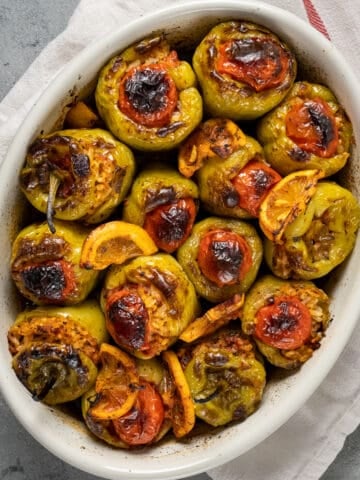
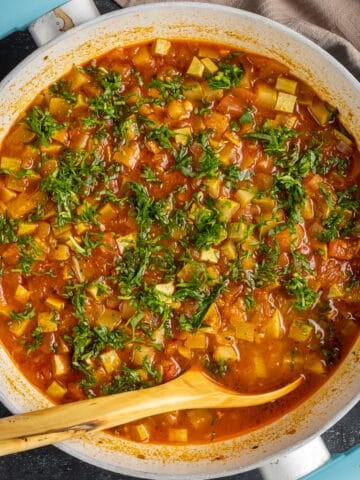
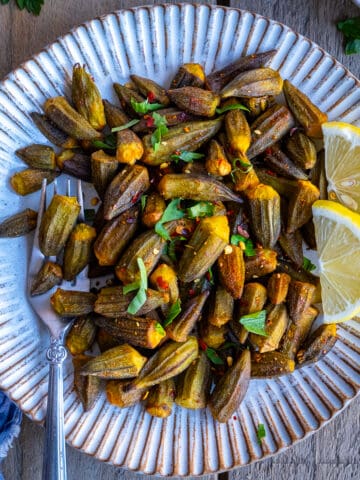
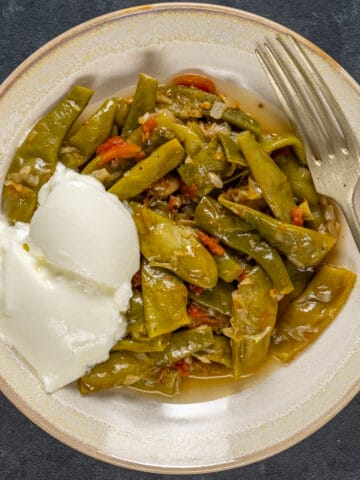
Mehmet Doktan says
Super I love Okra and when I make it invite my Australian friends they love it too. Thank you for sharing and keep up your good work